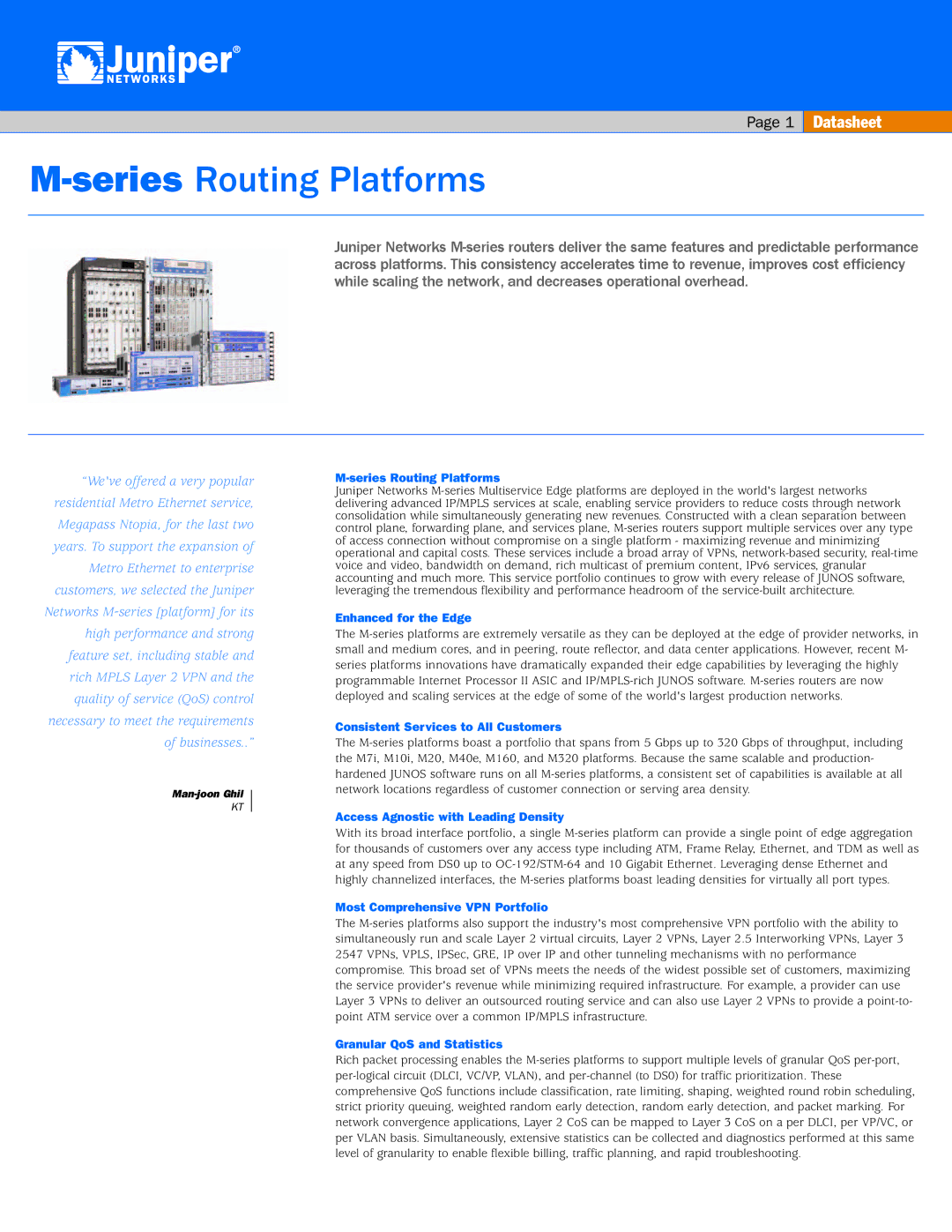M-series Routing Platforms
Juniper Networks M-series Multiservice Edge platforms are deployed in the world's largest networks delivering advanced IP/MPLS services at scale, enabling service providers to reduce costs through network consolidation while simultaneously generating new revenues. Constructed with a clean separation between control plane, forwarding plane, and services plane, M-series routers support multiple services over any type of access connection without compromise on a single platform - maximizing revenue and minimizing operational and capital costs. These services include a broad array of VPNs, network-based security, real-time voice and video, bandwidth on demand, rich multicast of premium content, IPv6 services, granular accounting and much more. This service portfolio continues to grow with every release of JUNOS software, leveraging the tremendous flexibility and performance headroom of the service-built architecture.
Enhanced for the Edge
The M-series platforms are extremely versatile as they can be deployed at the edge of provider networks, in small and medium cores, and in peering, route reflector, and data center applications. However, recent M- series platforms innovations have dramatically expanded their edge capabilities by leveraging the highly programmable Internet Processor II ASIC and IP/MPLS-rich JUNOS software. M-series routers are now deployed and scaling services at the edge of some of the world's largest production networks.
Consistent Services to All Customers
The M-series platforms boast a portfolio that spans from 5 Gbps up to 320 Gbps of throughput, including the M7i, M10i, M20, M40e, M160, and M320 platforms. Because the same scalable and production- hardened JUNOS software runs on all M-series platforms, a consistent set of capabilities is available at all network locations regardless of customer connection or serving area density.
Access Agnostic with Leading Density
With its broad interface portfolio, a single M-series platform can provide a single point of edge aggregation for thousands of customers over any access type including ATM, Frame Relay, Ethernet, and TDM as well as at any speed from DS0 up to OC-192/STM-64 and 10 Gigabit Ethernet. Leveraging dense Ethernet and highly channelized interfaces, the M-series platforms boast leading densities for virtually all port types.
Most Comprehensive VPN Portfolio
The M-series platforms also support the industry's most comprehensive VPN portfolio with the ability to simultaneously run and scale Layer 2 virtual circuits, Layer 2 VPNs, Layer 2.5 Interworking VPNs, Layer 3 2547 VPNs, VPLS, IPSec, GRE, IP over IP and other tunneling mechanisms with no performance compromise. This broad set of VPNs meets the needs of the widest possible set of customers, maximizing the service provider's revenue while minimizing required infrastructure. For example, a provider can use Layer 3 VPNs to deliver an outsourced routing service and can also use Layer 2 VPNs to provide a point-to- point ATM service over a common IP/MPLS infrastructure.
Granular QoS and Statistics
Rich packet processing enables the M-series platforms to support multiple levels of granular QoS per-port, per-logical circuit (DLCI, VC/VP, VLAN), and per-channel (to DS0) for traffic prioritization. These comprehensive QoS functions include classification, rate limiting, shaping, weighted round robin scheduling, strict priority queuing, weighted random early detection, random early detection, and packet marking. For network convergence applications, Layer 2 CoS can be mapped to Layer 3 CoS on a per DLCI, per VP/VC, or per VLAN basis. Simultaneously, extensive statistics can be collected and diagnostics performed at this same level of granularity to enable flexible billing, traffic planning, and rapid troubleshooting.

